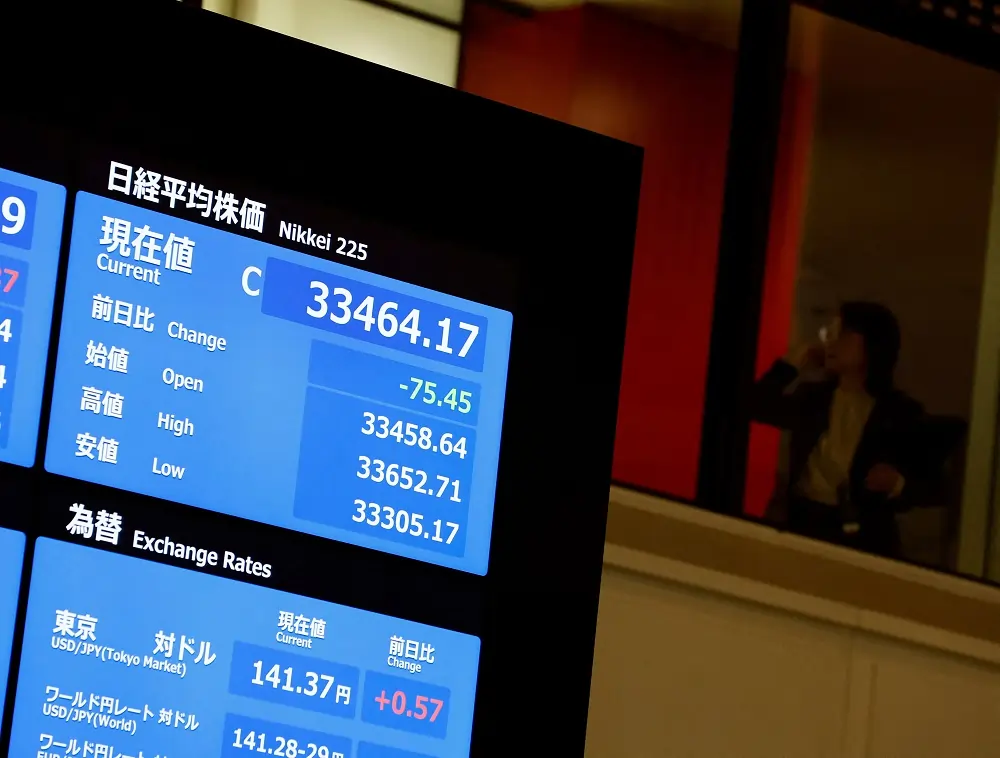
NEW YORK (Reuters) – U.S. stocks edged lower while the dollar gathered strength as the World Economic Forum in Davos entered its second day amid warnings that markets might have gotten ahead of themselves with respect to the timing and extent of central bank policy cuts.
The three major U.S. stock market indexes were lower after paring initial losses, while the greenback strength against a basket of world currencies waned a bit after the first hour of trading.
“Some of the cautiousness that’s coming out of Davos, that central banks may not live up to the rate cut expectations that the market has rallying on, and I think that’s why we’re having this weakness,” said Peter Cardillo, chief market economist at Spartan Capital Securities in New York.
At last glance, financial markets were pricing in a 68.1% likelihood of a 25 basis point interest rate cut at the conclusion of the U.S. Federal Reserve’s March meeting, according to CME’s FedWatch tool.
“That could change as earnings roll out,” Cardillo added. “So far, the bank earnings have not been that great.”
The fourth-quarter earnings season has just burst through the starting gate, with only 29 companies in the S&P 500 having reported as of Friday.
Analysts currently see aggregate annual S&P earnings growth of 4.4% in the October-December period, down from 11% at the start of that period.
Investors were also parsing a raft of other political and geopolitical developments, including Donald Trump securing a resounding win in the first 2024 U.S. Republican presidential contest in Iowa on Monday, and developments in the Red Sea, Gaza and Ukraine.
The Dow Jones Industrial Average fell 210.6 points, or 0.56%, to 37,382.38, the S&P 500 lost 14.02 points, or 0.29%, to 4,769.81 and the Nasdaq Composite dropped 20.91 points, or 0.14%, to 14,951.85.
European shares also came under pressure due to less optimistic rate cut expectations in the wake of recent comments by European Central Bank officials.
The pan-European STOXX 600 index lost 0.31% and MSCI’s gauge of stocks across the globe shed 0.67%.
Emerging market stocks lost 1.63%. MSCI’s broadest index of Asia-Pacific shares outside Japan closed 1.77% lower, while Japan’s Nikkei lost 0.79%.
The dollar advanced against a basket of world currencies amid waning rate cut bets and simmering tensions in the Middle East.
“The Fed commentary favors the dollar and geopolitical concerns continue to grow, so the dollar becomes a safety play,” Cardillo said.
The dollar index rose 0.75%, with the euro down 0.69% to $1.0873.
The Japanese yen weakened 0.86% versus the greenback at 147.03 per dollar, while Sterling was last trading at $1.2649, down 0.60% on the day.
U.S. Treasury yields headed higher as the previous week’s bullish sentiment dampened and central bankers in Europe and the United States pushed back against market expectations of imminent rate cuts.
Benchmark 10-year notes last fell 24/32 in price to yield 4.041%, from 3.95% late on Friday.
The 30-year bond last fell 48/32 in price to yield 4.2815%, from 4.198% late on Friday.
Crude prices reversed earlier gains and turned lower as concerns over dampening demand outweigh supply concerns arising from simmering tensions in the Middle East.
U.S. crude fell 0.88% to $72.04 per barrel and Brent was last at $77.99, down 0.2% on the day.
Gold prices dipped in opposition to the strengthening dollar.
Spot gold dropped 1.0% to $2,034.59 an ounce.
(Reporting by Stephen Culp; Additional reporting by Tom Westbrook in Singapore and Alun John in London; Editing by Jonathan Oatis)


